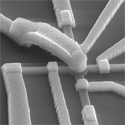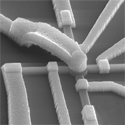Two in one
One way to reduce power consumption in computers is to build memory and logical processing into a single structure, which avoids the heat generated by shuttling data (in the form of a current) back and forth.
In a paper appearing in Physical Review Letters, Stefan Mark and colleagues at the University of Würzburg, Germany, present a single device made out of the ferromagnetic semiconductor that combines read/write capability with a simple logical process.
The team carves 70-nm-thick into a miniature cross, with four narrow bars extending north, south, east, and west from a central, circular disk. Electrical current and magnetization are coupled in , so the magnetization of any one bar, which is always along its length, determines the spin polarization of a current running through it. The polarized current from a north-south or east-west bar magnetizes (writes) the central disk in either a “0” or “1” state, respectively. One reads the device by measuring the resistance across a tunnel junction connecting a bar and the disk. This resistance is higher for “1” than “0.” By merging two such devices, the team is also able to build simple “XOR” logical gates, and other logic gates are possible in principle.
is only ferromagnetic at low temperatures and not currently practical for applications. But when the right material comes along (and materials science is looking in this direction), Mark et al.’s device could be one of several promising all-electrical, nonvolatile alternatives to silicon. – Jessica Thomas





